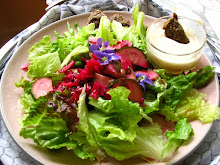Secret Stash
Vanilla Peanut-butter Fudge
 A tribute to My Dad, Earl Stephan Jacobson, a “Black Norwegian” from Duluth, MN who made KILLER FUDGE on Christmas and whenever we asked him to …all winter long. He always made a ton of chocolate fudge with black walnuts for all of us AND a small amount Vanilla with Peanut butter, for himself. His recipes were buried with the cane sugar long ago.
A tribute to My Dad, Earl Stephan Jacobson, a “Black Norwegian” from Duluth, MN who made KILLER FUDGE on Christmas and whenever we asked him to …all winter long. He always made a ton of chocolate fudge with black walnuts for all of us AND a small amount Vanilla with Peanut butter, for himself. His recipes were buried with the cane sugar long ago.Here is my raw-modern-version. You can make a larger quantity. But, you might eat it all and make yourself sick. It's so good; you'll be fighting over who gets to lick the spatula!
Secret Stash Vanilla Peanut-butter Fudge Recipe
Ingredients:
for the : Base"Add equal amounts of the following to the food processor:
- Raw honey
- Coconut oil
- Coconut butter
- Scrapings from one whole split vanilla bean
- 1/4 tsp of liquid almond extract
- 2 TBS of peanut butter from New Mexico
- Very scant 1/2 of a pinch of Himalayan sea salt (optional)
Blend until smooth. Pour into a glass dish. Refrigerate until firm.
If you can keep yourself from "tasting it" with a spoon every 20 minutes, you will have fudge in about an hour.
Slice with a warm knife. Serve on chilled plates.
For a full Batch of the Dark Rich Chocolate Version:
Add equal amounts of:
(For a full “batch” to fill a 9 X 13 glass dish, you will need 2 cups of each)
If you can keep yourself from "tasting it" with a spoon every 20 minutes, you will have fudge in about an hour.
Slice with a warm knife. Serve on chilled plates.
For a full Batch of the Dark Rich Chocolate Version:
Add equal amounts of:
- Raw honey
- Coconut oil
- Coconut butter
(For a full “batch” to fill a 9 X 13 glass dish, you will need 2 cups of each)
Season as follows:
Blend until smooth. Stir in a little over half of black walnuts. Pour into a glass dish. Refrigerate until almost firm, sprinkle with more black walnuts and homemade chocolate chips.* Press down with a spatula, if needed to stick to the top. Refrigerate until firm. Slice with a warm knife serve on chilled plates.
*Homemade Chocolate Chips
- Scrapings from 4 whole split vanilla bean
- 1 tsp of liquid almond extract
- 3 TBS of carob powder
- 1 tsp of raw cacao powder
- 1 cup of black walnut pieces (divided)
- 2 tsp of grade B maple syrup (optional)
- A pinch of Himalayan sea salt (optional)
- Home-made Chocolate Chips (optional)
Blend until smooth. Stir in a little over half of black walnuts. Pour into a glass dish. Refrigerate until almost firm, sprinkle with more black walnuts and homemade chocolate chips.* Press down with a spatula, if needed to stick to the top. Refrigerate until firm. Slice with a warm knife serve on chilled plates.
*Homemade Chocolate Chips
Ingredients:
(This makes a very dark rich bitter chocolate chip. For a semi-sweet, only use 1 tsp of raw carob; increase the raw cocoa powder to 1 TBS and add 1 TBS of white agavi nectar. You might not need the water.)
Process until smooth. Transfer to a plastic bag with the tip cut or a pastry bag with a small tip. Squeeze out “chip shapes” onto parchment paper. They don’t have to be perfect. (To get around this step, simply spread the chocolate batter like frosting on a sheet of parchment and then crumble into chips after it freezes.) Put in freezer until firm. Remove from parchment. Store in a glass container in the freezer until ready to use.
- 1/2 cup coconut oil
 1 cup coconut or cocoa butter
1 cup coconut or cocoa butter- 1 TBS of Grade B maple syrup
- 2 TBS raw carob powder
- 2 tsp of raw cocoa powder
- 1/4 tsp of Himalayan pink salt
- 1/4 tsp green stevia powder
- 1/4 tsp almond extract
- 1 TBS of warm water
(This makes a very dark rich bitter chocolate chip. For a semi-sweet, only use 1 tsp of raw carob; increase the raw cocoa powder to 1 TBS and add 1 TBS of white agavi nectar. You might not need the water.)
Process until smooth. Transfer to a plastic bag with the tip cut or a pastry bag with a small tip. Squeeze out “chip shapes” onto parchment paper. They don’t have to be perfect. (To get around this step, simply spread the chocolate batter like frosting on a sheet of parchment and then crumble into chips after it freezes.) Put in freezer until firm. Remove from parchment. Store in a glass container in the freezer until ready to use.
How is THIS Healthy?
Here is an excerpt from Jim Fly's newsletter that answers many questions about coconuts:
Our emphasis this week is on coconut products, which have proliferated in recent years as more and more research validates the healthfulness and unique properties of this tropical tree fruit.
I recall going to a seminar in Las Vegas several years ago given by Dr. Bruce Fife, N.D., the individual who has written the most about the often-misaligned coconut--(it's high in saturated fat, for example).
At that time, coconut oil and various other products were just being introduced to the health food industry. Previous to this, coconut, due to its high content of saturated fat, was being partially blamed for the high rate of heart disease. Remember the movie popcorn scare? But, as Dr. Fife pointed out it was precisely partially or fully hydrogentated coconut oil that was the real culprit, just as other healthy oils become dangerous when subjected to the hydrogenation process, which produces transfats, or plastic fats, that oxidize LDL cholesterol and set the stage for hardening of the arteries...
South Sea Islanders and other people living in the tropics, when eating a traditional diet that relies heavily on coconuts, have one of the lowest rates of heart disease in the world. And, here's why, according to Dr. Fife:
Coconut's saturated fat is a unique type of fat composed of Medium Chain Triglycerides, which the body mainly burns as fuel instead of storing as fat! Coconut also contains lauric acid which the human body turns into monolaurin, an antiviral, antifungal and antibacterial substance. Another MCT in coconut is capric acid, which converts into monocaprin, another antiviral. So, the theory goes, Coconut can possibly function as a metabolizer and immune system booster. At any rate, it is not the skull-and-crossbones fat of culinary paranoia. Oh, and by the way, pure coconut and coconut oil is one of the most hypoallergenic foods there is--most people with food allergies do not react negatively to coconut.
I recall going to a seminar in Las Vegas several years ago given by Dr. Bruce Fife, N.D., the individual who has written the most about the often-misaligned coconut--(it's high in saturated fat, for example).
At that time, coconut oil and various other products were just being introduced to the health food industry. Previous to this, coconut, due to its high content of saturated fat, was being partially blamed for the high rate of heart disease. Remember the movie popcorn scare? But, as Dr. Fife pointed out it was precisely partially or fully hydrogentated coconut oil that was the real culprit, just as other healthy oils become dangerous when subjected to the hydrogenation process, which produces transfats, or plastic fats, that oxidize LDL cholesterol and set the stage for hardening of the arteries...
South Sea Islanders and other people living in the tropics, when eating a traditional diet that relies heavily on coconuts, have one of the lowest rates of heart disease in the world. And, here's why, according to Dr. Fife:
Coconut's saturated fat is a unique type of fat composed of Medium Chain Triglycerides, which the body mainly burns as fuel instead of storing as fat! Coconut also contains lauric acid which the human body turns into monolaurin, an antiviral, antifungal and antibacterial substance. Another MCT in coconut is capric acid, which converts into monocaprin, another antiviral. So, the theory goes, Coconut can possibly function as a metabolizer and immune system booster. At any rate, it is not the skull-and-crossbones fat of culinary paranoia. Oh, and by the way, pure coconut and coconut oil is one of the most hypoallergenic foods there is--most people with food allergies do not react negatively to coconut.






